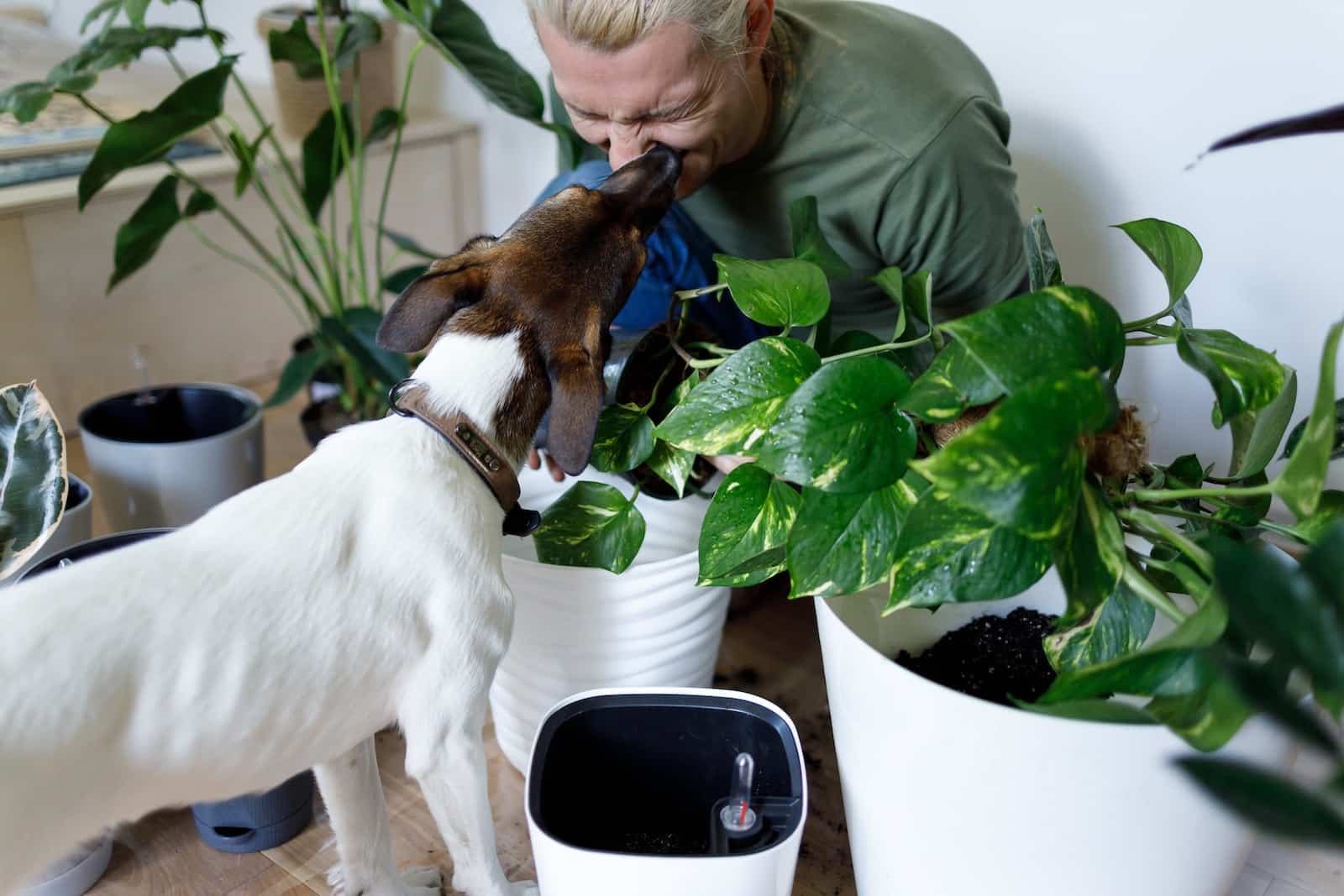Houseplants are a great way to bring some life and energy into your home. Not only do they look beautiful, but they can also be very beneficial for your health. But what if you have pets in the house? Are there pet friendly houseplants that won’t harm them? The answer is yes! In this article, we will explore the different types of pet-friendly houseplants that can make both pets and their owners happy.
Pets are an important part of our lives, so it’s essential to create a safe environment for them to live in. Pet-safe plants provide a great opportunity for us to be able to share our living space with our furry friends without having to worry about any potential dangers. There are many beautiful varieties of pet friendly houseplants that not only look good but can also help improve air quality and reduce stress levels in the home.
Not only do these plants add beauty and life to any room, but they can also help purify the air by absorbing pollutants and toxins. In addition, some of these plants even have calming properties which can reduce stress and anxiety levels in both humans and animals alike. So if you’re looking for a way to make your home more inviting while keeping your pet safe, then adding some pet friendly houseplants is definitely worth considering!
1. Benefits Of Having Pet Friendly Houseplants
Having pet friendly houseplants in your home is a great way to bring the outdoors in, without having to worry about endangering your furry friends. They can benefit both you and your pet in many ways! From providing air purification, to giving you peace of mind knowing that there will be no accidental ingestion of toxic plants, these plants offer more than just a pop of color and life indoors.
The first key benefit of having pet friendly houseplants is that they help increase air quality by removing pollutants such as carbon dioxide, formaldehyde and benzene from the air. This can help reduce allergies and other respiratory problems. Additionally, they can absorb airborne moisture which can help prevent mold growth – something that’s especially important if your pet has asthma or other respiratory issues.
Studies have also found that having plants around can reduce stress levels for both people and their pets. Watching fish swim in an aquarium or birds flutter around a room full of foliage has been proven to lower heart rate and blood pressure. Not only does this make for a more peaceful atmosphere for everyone living in the house, but it also helps create an environment where pets are less likely to get stressed out or anxious which can lead to destructive behavior like chewing furniture or barking excessively.
These are just some of the reasons why it’s beneficial to have pet friendly houseplants inside your home. With all the positive effects they offer both you and your furry friends, there’s no reason not to consider adding some greenery into your space! Moving forward, let’s take a look at the different types of pet friendly houseplants you can choose from to create a healthier living environment for everyone involved.
2. Types Of Pet Friendly Houseplants
Having pet friendly houseplants in your home can provide numerous benefits. Now that you’ve acquired a better understanding of why these plants are important to have, it’s time to explore the types available for purchase.
There are a wide variety of pet friendly houseplants on the market. Here are five of the top choices:
- Snake Plant (Sansevieria): This plant is easy to care for and adds an elegant look to any room.
- Spider Plant (Chlorophytum): Not only does it make a great conversation piece, but it also helps purify the air in your home.
- English Ivy (Hedera Helix): A popular choice among pet owners, this plant is low maintenance and can help filter out toxins from the air.
- Cast Iron Plant (Aspidistra Elatior): This is one of the most durable pet friendly houseplants, making it ideal for busy pet owners who don’t have much time on their hands.
- Peace Lily (Spathiphyllum): This lush green plant looks beautiful and requires minimal care.
- Boston Fern (Nephrolepis exaltata): A classic fern that can add a touch of greenery to any room. It’s also a great air purifier.
- African Violet (Saintpaulia): This small, colorful plant is safe for pets and can bloom all year round with the right care.
- Parlor Palm (Chamaedorea elegans): This palm is another great option for pet owners, as it’s non-toxic and easy to care for.
- Friendship Plant (Pilea involucrata): This plant has unique round leaves and is safe for pets. It also propagates easily, making it a fun plant to share with friends.
- Bamboo Palm (Chamaedorea seifrizii): This plant can add a tropical touch to your home and is safe for pets. It’s also a good air purifier, removing toxins like formaldehyde from the air.
- Baby Rubber Plant (Peperomia obtusifolia): This small, easy-to-care-for plant has thick, glossy leaves and is safe for pets. It’s also great for those who don’t have a lot of space, as it doesn’t grow too big.
- Calathea (Calathea spp.): There are many different species of Calathea, all of which are safe for pets. These plants have beautiful, patterned leaves and can add a pop of color to any room.
- Ponytail Palm (Beaucarnea recurvata): This unique-looking plant has a bulbous base and long, thin leaves. It’s safe for pets and can add a touch of whimsy to your home.
- Zebra Plant (Aphelandra squarrosa): This plant has striking, striped leaves and produces beautiful yellow flowers. It’s safe for pets and can add a bold pop of color to any room.
- Haworthia (Haworthia spp.): This succulent is safe for pets and is easy to care for. It has small, pointy leaves and can be a great addition to a windowsill or desk.
- Asparagus Fern (Asparagus aethiopicus): This fern has soft, feathery foliage and is safe for pets.
- Baby’s Tears (Soleirolia soleirolii): This delicate plant has small, round leaves and is safe for pets.
- Bamboo (Bambusoideae): These plants are safe for pets and can add a touch of zen to your home.
- Bird’s Nest Fern (Asplenium nidus): This fern has beautiful, wide fronds and is safe for pets.
- Burro’s Tail (Sedum morganianum): This succulent has long, trailing stems and is safe for pets.
- Christmas Cactus (Schlumbergera spp.): This plant blooms during the holiday season and is safe for pets.
- Coleus (Plectranthus scutellarioides): This plant has colorful, patterned leaves and is safe for pets.
- Dwarf Banana (Musa acuminata): This small banana plant is safe for pets and can add a tropical touch to your home.
- Easter Cactus (Hatiora gaertneri): This plant blooms around Easter and is safe for pets.
- Fittonia (Fittonia spp.): This plant has striking, veined leaves and is safe for pets.
- Goldfish Plant (Nematanthus gregarius): This plant produces small, orange flowers and is safe for pets.
- Grape Ivy (Cissus rhombifolia): This ivy has grape-like leaves and is safe for pets.
- Hoya (Hoya spp.): This plant has waxy, star-shaped flowers and is safe for pets.
- Lipstick Plant (Aeschynanthus spp.): This plant has unique, tube-shaped flowers and is safe for pets.
- Moth Orchid (Phalaenopsis spp.): This orchid is safe for pets and can add a touch of elegance to any room.
- Nerve Plant (Fittonia verschaffeltii): This plant has colorful, veined leaves and is safe for pets.
- Norfolk Island Pine (Araucaria heterophylla): This plant has a Christmas tree-like appearance and is safe for pets.
- Pilea (Pilea cadierei): This plant has silver and green foliage and is safe for pets.
- Prayer Plant (Maranta leuconeura): This plant has beautiful, patterned leaves and is safe for pets.
- Red Maranta (Maranta leuconeura erythroneura): This prayer plant has red veins and is safe for pets.
- Rubber Plant (Ficus elastica): This plant has large, glossy leaves and is safe for pets.
- Schefflera (Schefflera arboricola): This plant has glossy, umbrella-shaped leaves and is safe for pets.
- Silver Nerve Plant (Fittonia argyroneura): This plant has silver and green foliage and is safe for pets.
- Spiderwort (Tradescantia zebrina): This plant has striped leaves and is safe for pets.
- String of Pearls (Senecio rowleyanus): This succulent has long, trailing stems and is safe for pets.
- Swedish Ivy (Plectranthus verticillatus): This ivy has round, scalloped leaves and is safe for pets.
- Ti Plant (Cordyline fruticosa): This plant has colorful, sword-shaped leaves and is safe for pets.
When caring for pet friendly houseplants, it’s important to follow basic guidelines such as providing adequate water and light as well as removing any fallen leaves or flowers that could be toxic if ingested by pets. With just a few simple steps, you can enjoy all the benefits these plants offer while keeping your furry friends safe. With that said, let’s move on to discussing where to buy pet friendly houseplants.
3. Where To Purchase Pet Friendly Houseplants
Shopping for pet friendly houseplants? You’re not alone! Many of us want to add beautiful plants to our home, but also want to make sure our fur-babies are safe. So, where do you go to find pet friendly houseplants? Let’s take a look.
First, consider your local nursery or garden center. They’ll have a variety of plants that are safe for animals. Plus, they may offer advice on which plants are best for your specific pets and home. Another great option is online shopping. You can find pet friendly options at many popular plant shops like The Sill and Bloomscape. Shopping online offers convenience and access to even more varieties of pet friendly plants.
Finally, don’t forget about your local farmer’s market or plant swap! These typically have a wide selection of unique plants and might even provide expert advice from the sellers themselves. With so many options available, finding the perfect pet friendly houseplant has never been easier! Now that you know where to buy these special plants, let’s dive into caring for them correctly.
4. How To Care For Pet Friendly Houseplants
Caring for your pet friendly house plants can be a great way to bring life and vitality into your home. It’s also an opportunity to give something back to the environment by growing a living, breathing thing that will provide beauty and respite from an ever-changing world.
Just like us, plants need food and water to survive. Plants are also sensitive to their surroundings and certain types of care can help them thrive. To get the most out of your pet friendly houseplants, you’ll want to provide them with adequate light, humidity and temperature regulation. For example, if you have an indoor garden, make sure that you position the plants so they receive enough sunlight without getting too hot or cold. Additionally, use soil specifically made for pet friendly houseplants since it provides better drainage and aeration than regular potting mix.
Finally, don’t forget about watering your plants – it’s essential for keeping them growing well! While different species require different amounts of water, as a general rule of thumb water when the top inch of soil is dry. When it comes time to fertilize your plants use a natural fertilizer like fish emulsion or compost tea as these are less likely to be harmful for pets if ingested.
By providing proper care for your pet friendly houseplants you can ensure that they last for years to come – giving both you and your furry friends plenty of joy in return! With diligence and knowledge, caring for pet friendly houseplants is easy. Now all that’s left is to figure out how best to keep pets away from non-pet friendly plants in your home!
5. How To Keep Pets Away From Non-Pet Friendly Houseplants
Caring for your pet friendly houseplants doesn’t have to be a difficult task, but when it comes to keeping pets away from non-pet friendly plants, it can be a challenge. As pet owners, our primary concern is ensuring that our beloved family members don’t come into contact with any plants that may cause them harm. So what are some ways we can keep our furry friends away from those potentially dangerous plants?
One of the best ways to keep pets away from non-pet friendly plants is to create physical boundaries. This could include moving the plant out of reach or placing it behind an obstruction such as a fence or gate. Additionally, you could place an area rug or other fabric covering around the base of the plant to act as a barrier and prevent your pet from getting too close.
You should also consider using natural deterrents. Some common household items like citrus peels, garlic cloves, coffee grounds, and hot pepper flakes can be used to deter animals from approaching certain areas in your home. In addition to these items, there are also products specifically designed for pet repellent available in many pet stores.
These simple steps can help protect your beloved pets from any potential harm caused by non-pet friendly plants. It’s important to remember though that these measures alone may not completely prevent your pet from coming into contact with these types of plants. That’s why it’s important to stay vigilant and monitor their behavior around them just in case. With careful consideration and proactive prevention strategies, you can ensure that both you and your pet enjoy living safely side by side with all kinds of houseplants! Now let’s take a look at the potential side effects of pets ingesting non-pet friendly plants…
6. Potential Side Effects Of Pets Ingesting Non-Pet Friendly Plants
Plants can be a beautiful addition to any home, but when it comes to pets, caution must be taken. Just like a chess game, understanding what is safe and what isn’t for your pet is key. Pet friendly houseplants are the pieces that won’t cause harm if ingested by our furry friends.
Unfortunately, there are potential side effects of pets ingesting non-pet friendly plants:
• Vomiting & Diarrhea: These symptoms may occur with ingestion of any toxic plant material.
• Drooling & Uncoordinated Movement: Pets may start drooling excessively or have difficulty walking or standing up.
• Seizures & Heart Arrhythmias: In serious cases, seizures and heart arrhythmias can result from toxicity due to non-pet friendly plants.
Be sure to inspect your pet’s environment for any potentially dangerous plants as well as keeping an eye out for signs of distress such as vomiting and diarrhea. Don’t wait until it’s too late – early detection and removal of the source are key in preventing further complications from occurring. With this knowledge, you can now make an informed decision about which houseplants are safe for your home and family.
7. What To Do If Your Pet Ingests A Non-Pet Friendly Plant
Oh no! Your pet has ingested a non-pet friendly plant and now what? Thankfully, there are some steps you can take to help your furry friend if they have consumed something potentially dangerous. With the right information and a little bit of luck, you can get through this scary situation with your pet safe and sound.
First off, it’s important to stay calm and assess the situation. It may be helpful to look up the toxicity levels of the plant your pet has eaten. If the plant is toxic, do not induce vomiting without consulting with a veterinarian first as it could cause more harm than good. If you can’t reach a vet right away, contact an animal poison control center for advice on what next steps to take.
If possible, try to identify how much of the plant your pet ate so that you can provide this information when speaking with your vet or poison control center representative. Depending on the type of plant, symptoms may range from minor discomfort to serious health issues like organ failure or seizures. Knowing what was ingested will help determine the best course of action for treatment.
No matter how careful we are about keeping our houseplants out of reach from our pets, accidents can still happen. Get all the facts before taking any actions so that you can make sure your pet gets proper care and treatment if necessary.
8. Tips For Keeping Pets And Houseplants Separate
Keeping pets safe around houseplants can be like walking a tightrope – it’s tricky, yet doable with the right knowledge. Just like the saying goes, ‘prevention is better than cure’, and this certainly applies to keeping your pet safe from ingesting toxic plants. With that in mind, here are some tips to help you along:
- Do your research – take the time to find out which plants are pet friendly and which ones are not so you can keep them separate.
- Place pet-friendly plants in raised containers – this will make them less accessible and much harder for your pet to reach or get into trouble with.
- Look out for signs of distress – if your pet is showing any signs of discomfort after coming into contact with a plant, take them to the vet immediately.
As well as taking these steps, there are also natural ways that you can repel pets from houseplants such as using citrus peels or cayenne pepper flakes. Planting these deterrents near your houseplants can help keep curious pets away and keep your home a safe, pet-friendly environment for everyone to enjoy!
9. Natural Ways To Repel Pets From Houseplants
Preserving pet-plant peace is paramount for harmonious homes. From natural repellents to nimble strategies, there are numerous nifty ways to keep pets and plants apart. Nurturing a safe space, free from potential dangers, ensures both pets and plants remain in good health.
Using natural means to repel pets from houseplants is an effective approach. Scattering citrus peels near plants deters cats and dogs from munching on foliage, while growing herbs such as lavender or rosemary can help protect against nibbling critters too. Additionally, strategically placing spiky foliage in the vicinity of vulnerable houseplants may also safeguard them from curious pet paws or inquisitive noses.
Another useful tactic is to place barriers around delicate houseplants that might be appealing to pets. Transparent plastic guards provide an additional layer of defense while still allowing light and air through; alternatively, decorative plant stands can also help keep inquisitive noses at bay.
No matter the method deployed, taking proactive steps to ensure safety will produce positive results for all involved – humans, plants, and pets alike! With the right precautionary measures in place it’s possible to create an environment conducive for cohabitation between our furry friends and green companions alike – one that allows us all to thrive happily side by side.
10. How To Recognize Signs Of Plant Stress In Pets
Taking care of houseplants is a rewarding experience, but when pets are involved it can become a challenge. Identifying the signs of plant stress in pets, understanding natural ways to repel them from plants, and creating a pet-friendly environment around houseplants are all essential steps for successful houseplant ownership.
Recognizing the signs of plant stress in pets is an important part of being a responsible pet owner. This includes: observing changes in behavior; noticing if they’re scratching, sneezing, or wheezing excessively; and monitoring their intake of toxic chemicals from plants. If you spot any of these signs, take action immediately to mitigate the risk to your pet.
Creating a pet-friendly environment for houseplants means making sure that their access and exposure to plants is limited. Some practical solutions include using plant stands so pets won’t be able to reach them as easily, maintaining good air circulation in the room, and avoiding scented candles or essential oils near plants that could be dangerous to pets. Ultimately, being mindful and attentive can help you create a safe home for both your furry friends and your beloved plants.
11. How To Create A Pet Friendly Environment Around Houseplants
Surprisingly, creating a pet friendly environment around houseplants isn’t as difficult as you’d think. It’s actually quite straightforward when you know what to look for. But before we get into that, let’s take a step back and consider the irony of this situation. We want to bring life into our homes by growing plants, yet we need to be aware of how these plants affect our pets’ lives too!
Fortunately, there are a few key steps that can ensure both our furry friends and our plants remain healthy and safe. The first is just to be mindful of the types of plants you choose for your home. Not all houseplants are pet-friendly; some are highly toxic if ingested, so it’s best to research which ones are safe for your pet before buying them.
In addition to avoiding certain plants, it’s also important that you create a secure space where your pet won’t be tempted to play with or eat the plants. This means keeping them out of reach on high shelves or in hanging pots, or simply making sure your pet has access only to designated areas of the house where they can’t get close to the plants.
By taking these simple precautions, you can rest assured knowing that both your pets and your houseplants will remain safe and healthy in their shared environment. And with that peace of mind comes the joy of watching your beloved family members—human and animal—enjoy each other’s company in harmony. Now let’s explore some common questions about pet friendly houseplants…
12. Common Questions About Pet Friendly Houseplants
Pondering pet friendly plants? Puzzling over pet-safe foliage? With so many questions, it’s worth considering common queries about pet friendly houseplants. From their toxicity to their surface area, there are a few factors to factor in when finding flora for furry family members.
First and foremost, many owners ask how toxic these plants can be. Fortunately, most pet-friendly plants are non-toxic or minimally toxic – but it’s still important to double check the plant’s rating on the ASPCA website before bringing it into your home. Additionally, you’ll want to consider whether your animals can reach the plant – if not, you may be able to safely add more potentially hazardous varieties without worry.
Lastly, some people have concerns about the maintenance of these plants. Though they may take slightly more effort than typical houseplants due to their unique needs and preferences, most pet friendly plants don’t require any extraordinary care or attention – just basic pruning and watering!
With all this in mind, it’s easy to understand why so many people are turning towards pet friendly houseplants as alternatives for their homes.
13. Popular Alternatives To Pet Friendly Houseplants
Finding pet friendly houseplants is like searching for a needle in a haystack; it’s difficult, but with some patience and research, you can find the perfect plant. When it comes to pet-proofing your home, there are plenty of alternatives to traditional houseplants that won’t harm your furry friends. In this article, we’ll explore some popular alternatives to pet friendly houseplants.
One great alternative is artificial plants. They come in a variety of sizes, shapes, and colors and make great decorations for any room. Plus, since they’re not real plants, they won’t be harmful if your pets decide to take a bite out of them! Another great option is succulents; these small plants are easy to care for and require minimal water and sunlight. While succulents may not be as vibrant as traditional houseplants, they still make great additions to any home.
Finally, if you want something unique and eye-catching in your home that won’t harm your pet’s health, why not try hanging planters? Hanging planters are stylish and decorative without posing any risk to your pets. Whether you opt for faux plants or real ones, hanging planters add a touch of sophistication wherever you place them – making them ideal for adding personality to any space in your home.
With all these options available, you can create an inviting atmosphere without compromising on safety or style – an important consideration when it comes to protecting our beloved pets. Now let’s explore some planting and decorating ideas for pet friendly houseplants that will keep both you and your pets happy!
14. Planting And Decorating Ideas For Pet Friendly Houseplants
It’s time to bring some life into your home with pet friendly houseplants. Planting and decorating with these lush greens is an easy way to brighten up a room – and ensure your furry friends stay safe! Like a vivid canvas, the possibilities for creating a unique look are virtually endless.
As you get started on this project, consider the size of your plants in relation to the space they’ll go. Where will they be displayed? Will they be hung or propped up? If you have shelves or mantles, these can provide beautiful backdrops for larger plants. For those who want something more eye-catching, hanging baskets can be a great choice.
Your creativity is sure to reach new heights when it comes to choosing an array of colors and textures that compliment each other as well as the room itself. Whether you prefer subtle hues or bold splashes of color, there are plenty of options available that will fit into any space – and make it even more inviting! As you design your garden paradise, don’t forget about accessories like pots and planters that will add extra character to the display.
Your pet-friendly houseplant sanctuary is almost ready for its debut! With just a few touches here and there, it can become an oasis in any living space – one that not only looks amazing but also keeps all of your furry friends safe. Now it’s time to take a look at some considerations when choosing pet friendly houseplants for your home.
15. Considerations When Choosing Pet Friendly Houseplants
When it comes to choosing pet friendly houseplants, there are lots of considerations. For example, Leticia and her family recently adopted a puppy, and they wanted to make sure their home was pet-friendly. After doing research online and consulting with a local gardening expert, they decided on a few plants that would be safe for their new furry friend.
There are several things to keep in mind when selecting pet friendly houseplants. First, you’ll want to make sure the species isn’t toxic for your pets. Common plants like aloe vera, spider plants, snake plants and ivy are all safe options for cats and dogs. Additionally, you should look for varieties that don’t have thorns or spines which could hurt your pet if they were to get too close.
Finally, when it comes to placement of the plants in your home, you’ll want to ensure that they’re out of reach of your pet. If you’re worried about curious paws or snouts getting too close, consider hanging baskets or shelves instead of traditional pots on the floor. This way, you can enjoy the beauty of having greenery around without worrying about your pet’s safety.
Frequently Asked Questions
What Is The Best Pet Friendly Houseplant For My Particular Pet?
Choosing the best pet-friendly houseplant for your particular pet can be a daunting task. With so many different plants to choose from, it can be overwhelming to decide which one will be the best fit. Luckily, there are some helpful tips that can help you make a wise selection.
When selecting a pet-friendly houseplant, it’s important to consider the size and type of your pet. If you have a small pet like a hamster or gerbil, you’ll want to choose smaller plants such as spider plants, peace lilies, and Pothos. For larger pets like cats or dogs, opt for bigger plants such as ficus trees or snake plants that are more sturdy and unlikely to be damaged by playful paws.
The environment in which your pet lives is also an important factor when deciding on the right plant. If your pet lives in an area with plenty of sunlight, then you should choose sun-loving plants such as aloe vera or gerbera daisies. On the other hand, if they live in a darker environment you may want to pick low light tolerant varieties such as pothos or ZZ plants.
No matter which type of plant you ultimately decide upon, always remember that safety is key when selecting any home decor item for your pet’s living space. Look for plants that are non-toxic and unlikely to cause any harm if ingested by your furry friends! With this knowledge in mind and these tips in hand, finding the perfect pet-friendly houseplant for your special companion should be much easier than before!
Is There A Way To Make Non-Pet Friendly Houseplants Safe For Pets?
Owning a pet comes with a lot of responsibilities. One of them is to make sure that any plants in the house are safe for your pet. Take, for example, Joe and his dog Sparky. Joe recently moved into a new home and wanted to spruce it up with some plants. He was looking for plants that could be both aesthetically pleasing and pet friendly.
Unfortunately, not all houseplants are safe for animals to be around. But there are ways to make non-pet friendly houseplants safe for pets like Sparky. For instance, if you want to keep certain types of plants such as aloe vera or poinsettia, you should consider placing them out of reach from your pet or hanging them from the ceiling so they can’t be nibbled on. Additionally, spraying non-toxic plant protection products onto the leaves can help keep pets away from them.
It’s also important to check the label on any potting soil or fertilizer that comes with your houseplant as some may contain toxic ingredients that could put your pet at risk if ingested. By following these steps it’s possible to enjoy having beautiful houseplants while keeping your pet safe at the same time.
The key is to be mindful of what type of plants you bring into your home and how they are positioned within it – this way you can create an environment where everyone including your four-legged family members feel welcome!
Are There Any Pet Friendly Houseplants That Are Also Safe For Children?
Finding the right houseplants can be a challenge, especially when you have pets and children in your home. Having plants that are pet friendly but also safe for kids is an important consideration. Let’s take a look at some of the pet friendly houseplants that are also safe for children.
Many types of ferns are great options for pet friendly houseplants. The Boston Fern, one of the most popular varieties, is non-toxic to cats and dogs and requires minimal maintenance. Spider plants are another pet friendly variety that is known for being low maintenance and easy to care for. Not only are these plants safe for pets, they’re also safe for little ones too!
If you’re looking for something with a bit more color, why not try Succulents or Cacti? Both varieties require very little watering and thrive in sunny spots – perfect for busy households! Plus, both are non-toxic to cats and dogs so they make a great choice if you have four legged family members.
So there you have it: three pet friendly houseplant varieties that are also perfectly safe around children! They’re all easy to take care of too – perfect if you don’t have much time on your hands. With these three choices, finding the right plant doesn’t need to be a hassle!
How Often Should I Check My Pet Friendly Houseplants For Signs Of Pet Stress?
When you have pets and children in the home, it’s important to make sure your houseplants are safe for everyone. Pet-friendly plants are a great way to add some natural beauty to your home without worrying about your pet’s safety. But how often should you check for signs of pet stress when it comes to these plants?
The frequency of checking on your pet friendly houseplants depends on the type of plant you have. If you have high-maintenance plants, like fiddle leaf figs or calatheas, then you’ll need to check them more often. These types of plants require frequent watering and pruning, so checking them at least once a week will help ensure that your pet is not being exposed to any harmful toxins or allergens. On the other hand, if you have low-maintenance houseplants like cacti or succulents, then checking them every few weeks should suffice.
It’s also important to be aware of any changes in your pet’s behavior around your houseplants. If they start exhibiting signs such as sneezing or coughing, it might be an indication that they are having an allergic reaction and may need to be moved away from the plant. Keeping an eye out for any changes in their behavior can help keep both your pets and children safe around your houseplants.
By understanding the type of plant you have and monitoring any changes in behavior from both children and pets, you can ensure that everyone stays safe while still enjoying the beauty of nature indoors!
Are There Any Pet Friendly Houseplants That Are Easy To Maintain?
Do you want to add a bit of greenery to your home but don’t know what pet friendly houseplants are out there? With so many options, it can be daunting to pick the best ones. Fortunately, there are some great, easy-to-maintain pet friendly houseplants that will look great and won’t stress out your furry friends.
One of the most popular pet friendly houseplants is the spider plant. Its thick, tough leaves make it perfect for pets who like to chew on things – plus its tall shape adds an elegant touch to any room. Another fan favorite is the rubber tree, which is incredibly hardy and requires minimal care. Its waxy leaves also make it difficult for a pet to damage.
Finally, if you’re looking for something low-maintenance but still beautiful, consider some of these options:
- Succulents:
- Easy to grow and maintain
- Low water requirements
- Ivy:
- Great for trailing or hanging down from shelves or pots
- Looks amazing in a variety of planters
No matter what type of pet friendly houseplant you decide to go with, it’s important to check it regularly for signs of distress from your four-legged family members. A few minutes here and there can help ensure your furry friends stay safe and happy!
Conclusion
In conclusion, pet friendly houseplants can be a great way to add some life to your home while also keeping your pets safe. When selecting a plant for your home, consider the particular needs of your pet and make sure it is safe for them. You may also want to look into making non-pet friendly plants safe for pets by using natural or organic methods. Additionally, if you have children in the home, make sure that any pet friendly plants you choose are also child-safe as well. Finally, it is important to check on any pet friendly houseplants regularly and look out for signs of stress in your pet so that you can take them away from the plant if needed. All in all, with a little research and care, you can create an inviting environment for both you and your pet with some beautiful pet friendly houseplants! To paraphrase the old adage: with great flora comes great responsibility!





























